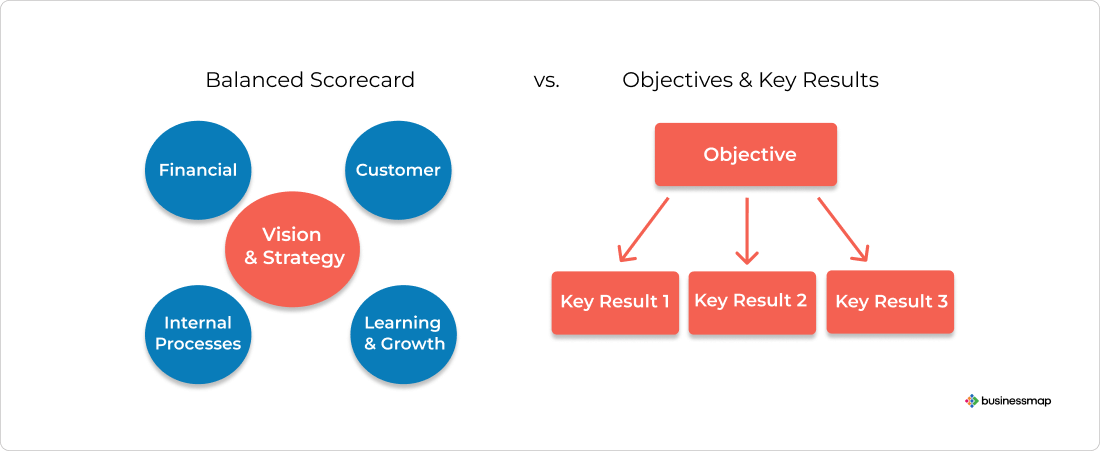OKRs and Balanced scorecard (BSC) are both strategic management tools designed to help you to define and achieve your goals. Besides the ways the two approaches differ from one another, they can be complementary and beneficial to achieving results. Understanding the driving forces behind each of the two approaches will help you apply their full power to your advantage.
What Are the Differences and Similarities between Balanced Scorecard and OKRs?
Three of the key distinguishing factors when talking OKRs vs. Balanced scorecard relate to the questions “What defines both?”, “What are their review cycles?” and “How are both related to performance reviews on an organizational level?”.
Let's explore them in more detail.
What Defines Balanced Scorecard and OKRs?
There are three underlined characteristics of the BSC at the root of its embrace by corporate strategic management since its appearance in the early 1990s. These include its focus on the organizational strategic goals and measuring their execution, as well as the four perspectives it takes into account when identifying the objectives and their cause-and-effect relationship - financial, customer, internal, and learning and growth.
OKRs also aims to connect the strategic vision to its execution and highlight the importance of tracking whether you're moving in the right direction. However, an essential aspect of the OKRs framework is the emphasis on ongoing priorities and answering the questions “Are we doing the right thing?” and “How do we know if we are succeeding or not?”
While transparency and alignment with the organizational goals are common traits to both, strategic management using the BSC takes a top-down approach when defining goals. Whereas OKRs promote a less cascading manner of setting goals. Ideally, high-level OKRs are defined on a strategic level, and teams are encouraged to develop their own OKRs contributing to the strategic ones.
How Are OKRs and BSC Similar?
Let’s start with the similarities between a Balanced scorecard and OKRs.
- OKR and BSC are both management tools that facilitate strategic goals definition.
- They help organizations determine execution plans to connect vision with actions.
- Organizations using OKRs and BSC develop metrics to track the progress of goals.
- Both frameworks rely on data for measurement and progress tracking, which makes them prominent tools for strategic management.
Major Differences between OKR and BSC
- The BSC takes a top-down approach to defining goals, while OKRs promote collaboration and feedback flowing top-down and bottom-up.
- BSC implementation requires that objectives are defined for each one of the four business perspectives - financial, customer, internal, learning & growth, and establishing a cause-effect relationship between the goals. In contrast, top-level OKRs are defined, and teams are encouraged to align their specific objectives to the strategy.
- The BSC has a more fragmented approach to defining goals making it harder to change, whereas the OKRs aim to reflect the priorities at hand and offer greater agility.
- Organizations often define over 10 objectives using the BSC framework, while OKRs promote less - usually between 3 to 5 goals.
- OKR-led strategies use quarterly or monthly reviews, while BSC employs annual cadences.
- Unlike OKRs, BSC performance metrics are often related to compensation.
 Balanced Scorecard structure to performance management vs. OKR goal-setting framework
Balanced Scorecard structure to performance management vs. OKR goal-setting framework
What Are the Performance Indicators in BSC and OKRs?
One of the leading causes for failing OKR and Balanced scorecard adoption is their too-literal interpretation as performance indicators. While both employ measures to indicate how well you achieve your goals, that data should be used to demonstrate the real value of your actions and not simply as KPIs.
In other words, instead of measuring the hours people spend in coaching and training to improve their soft skills, aim to track customer satisfaction with the service. Has it improved? Are there any emerging challenges among your collaborators? How to improve?
Good KPIs are essential to the success of Balanced scorecard strategies, however, KPIs can oftentimes be very output oriented. Alternatively, Key Results in OKR should measure the outcomes you seek to achieve that would bring you closer to your organizational goals.
OKRs and BSC Review Cycles
Regardless of the strategic approach you take at your organization, it’s critical to review and discuss how well you are executing the laid-out action plan.
While company OKRs can be developed on a quarterly or annual basis, they are reviewed throughout the entire strategy delivery cycle. The reviews can be held during regular meetings where findings are communicated without losing momentum.
A BSC strategy map is normally developed for a minimum of one year, so the review cycle is annual. Not discussing the pace of the strategy delivery could threaten the success of the entire strategy completion.
How to Get the Most of the Two Frameworks?
Together, OKRs and BSCs can help you create a global strategic map of your goals (BSC) and narrow down those that are most important (OKRs). Visualizing your strategy map using OKRs ensures global transparency and invites feedback from all business entities.
By visualizing the strategy and making it fully transparent, you ensure that company and team OKRs are constantly aligned with the organizational vision. Additionally, the frequent OKR review cycles make all necessary priority changes prominent, keeping your strategy up-to-date and relevant.
Senior-level management can benefit most from OKR goal-setting in conjunction with a Balanced scorecard strategy map. Essentially, OKRs ensure that goals and execution activities are aligned. Meanwhile, Key Results make achieving the objectives easier. You can, therefore, ensure alignment at all times between all entities that influence each other and always consider their impact.
We offer the most flexible software platform
for outcome-driven enterprise agility.
Related Articles





 Balanced Scorecard structure to performance management vs. OKR goal-setting framework
Balanced Scorecard structure to performance management vs. OKR goal-setting framework

